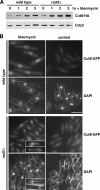Fission yeast Cut8 is required for the repair of DNA double-strand breaks, ribosomal DNA maintenance, and cell survival in the absence of Rqh1 helicase
- PMID: 17178839
- PMCID: PMC1820446
- DOI: 10.1128/MCB.01495-06
Fission yeast Cut8 is required for the repair of DNA double-strand breaks, ribosomal DNA maintenance, and cell survival in the absence of Rqh1 helicase
Abstract
Schizosaccharomyces pombe Rqh1 is a member of the RecQ DNA helicase family. Members of this protein family are mutated in cancer predisposition diseases, causing Bloom's, Werner, and Rothmund-Thomson syndromes. Rqh1 forms a complex with topoisomerase III and is proposed to process or disrupt aberrant recombination structures that arise during S phase to allow proper chromosome segregation during mitosis. Intriguingly, in the absence of Rqh1, processing of these structures appears to be dependent on Rad3 (human ATR) in a manner that is distinct from its role in checkpoint control. Here, we show that rad3 rqh1 mutants are normally committed to a lethal pathway of DNA repair requiring homologous recombination, but blocking this pathway by Rhp51 inactivation restores viability. Remarkably, viability is also restored by overexpression of Cut8, a nuclear envelope protein involved in tethering and proper function of the proteasome. In keeping with a recently described function of the proteasome in the repair of DNA double-strand breaks, we found that Cut8 is also required for DNA double-strand break repair and is essential for proper chromosome segregation in the absence of Rqh1, suggesting that these proteins might function in a common pathway in homologous recombination repair to ensure accurate nuclear division in S. pombe.
Figures







Similar articles
-
A role for the fission yeast Rqh1 helicase in chromosome segregation.J Cell Sci. 2005 Dec 15;118(Pt 24):5777-84. doi: 10.1242/jcs.02694. Epub 2005 Nov 22. J Cell Sci. 2005. PMID: 16303848
-
Yeast as a model system to study RecQ helicase function.DNA Repair (Amst). 2010 Mar 2;9(3):303-14. doi: 10.1016/j.dnarep.2009.12.007. Epub 2010 Jan 13. DNA Repair (Amst). 2010. PMID: 20071248 Review.
-
Long G2 accumulates recombination intermediates and disturbs chromosome segregation at dysfunction telomere in Schizosaccharomyces pombe.Biochem Biophys Res Commun. 2015 Aug 14;464(1):140-6. doi: 10.1016/j.bbrc.2015.06.098. Epub 2015 Jun 18. Biochem Biophys Res Commun. 2015. PMID: 26093291
-
Helicase activity is only partially required for Schizosaccharomyces pombe Rqh1p function.Yeast. 2002 Dec;19(16):1381-98. doi: 10.1002/yea.917. Yeast. 2002. PMID: 12478586
-
Maintenance of Yeast Genome Integrity by RecQ Family DNA Helicases.Genes (Basel). 2020 Feb 18;11(2):205. doi: 10.3390/genes11020205. Genes (Basel). 2020. PMID: 32085395 Free PMC article. Review.
Cited by
-
Break-induced ATR and Ddb1-Cul4(Cdt)² ubiquitin ligase-dependent nucleotide synthesis promotes homologous recombination repair in fission yeast.Genes Dev. 2010 Dec 1;24(23):2705-16. doi: 10.1101/gad.1970810. Genes Dev. 2010. PMID: 21123655 Free PMC article.
-
Fission yeast RecQ helicase Rqh1 is required for the maintenance of circular chromosomes.Mol Cell Biol. 2013 Mar;33(6):1175-87. doi: 10.1128/MCB.01713-12. Epub 2013 Jan 7. Mol Cell Biol. 2013. PMID: 23297345 Free PMC article.
-
Proteasome nuclear import mediated by Arc3 can influence efficient DNA damage repair and mitosis in Schizosaccharomyces pombe.Mol Biol Cell. 2010 Sep 15;21(18):3125-36. doi: 10.1091/mbc.E10-06-0506. Epub 2010 Jul 28. Mol Biol Cell. 2010. PMID: 20668161 Free PMC article.
-
Caffeine as a tool for investigating the integration of Cdc25 phosphorylation, activity and ubiquitin-dependent degradation in Schizosaccharomyces pombe.Cell Div. 2020 Jun 29;15:10. doi: 10.1186/s13008-020-00066-1. eCollection 2020. Cell Div. 2020. PMID: 32612670 Free PMC article. Review.
-
Redundant roles of Srs2 helicase and replication checkpoint in survival and rDNA maintenance in Schizosaccharomyces pombe.Mol Genet Genomics. 2009 May;281(5):497-509. doi: 10.1007/s00438-009-0426-x. Epub 2009 Feb 11. Mol Genet Genomics. 2009. PMID: 19205745
References
Publication types
MeSH terms
Substances
Grants and funding
LinkOut - more resources
Full Text Sources
Molecular Biology Databases
Miscellaneous
